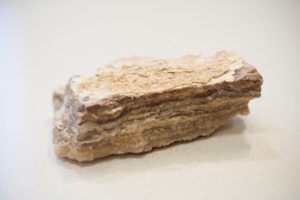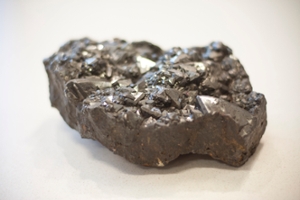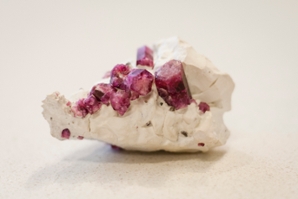Minerals at the Frehner Museum
Minerals are solid, inorganic substances that have a crystal structure. Utah’s unique landscape is a source for a variety of interesting gems and minerals. Our museum’s selection of minerals is a thing of beauty, one that must be seen in person to truly appreciate. Here are a few mineral samples that may be found in our collection.
Amethyst
 The amethyst is a semiprecious quartz stone that comes in a variety of violet shades and is often used in jewelry. Amethysts can change color when heated, and its color tone can fade over time, if overexposed to light sources. The name amethyst comes from the Ancient Greek word a-méthystos, meaning “not intoxicated,” and was believed to protect its owner from drunkenness. European soldiers wore amethyst amulets to battle, with the belief that the gem could heal its wearer and keep them calm in battle. It was once considered a very precious gem and used as a symbol of royalty, until large deposits were discovered in Brazil and its value decreased. Amethyst is the traditional birthstone for February.
The amethyst is a semiprecious quartz stone that comes in a variety of violet shades and is often used in jewelry. Amethysts can change color when heated, and its color tone can fade over time, if overexposed to light sources. The name amethyst comes from the Ancient Greek word a-méthystos, meaning “not intoxicated,” and was believed to protect its owner from drunkenness. European soldiers wore amethyst amulets to battle, with the belief that the gem could heal its wearer and keep them calm in battle. It was once considered a very precious gem and used as a symbol of royalty, until large deposits were discovered in Brazil and its value decreased. Amethyst is the traditional birthstone for February.
Banded Opal
 Known for its striped pattern, the banded opal has affectionately been named the Bacon Opal or the Candy Stripe Opal. The bands can be slightly translucent, usually in the clear-colored bands, and have red, white, pink, and yellow stripes. Hydrated silicon dioxide, the mineral needed to create this opal, is found in the western United States and Australia. This opal is another example of a rare mineral that is commonly found in Utah's Beaver County.
Known for its striped pattern, the banded opal has affectionately been named the Bacon Opal or the Candy Stripe Opal. The bands can be slightly translucent, usually in the clear-colored bands, and have red, white, pink, and yellow stripes. Hydrated silicon dioxide, the mineral needed to create this opal, is found in the western United States and Australia. This opal is another example of a rare mineral that is commonly found in Utah's Beaver County.
Magnetite
 Magnetite is the most magnetic of the few naturally-occurring magnetic minerals on Earth. It rarely forms crystals that are large enough to be seen in hand samples, making our specimen unique. Naturally-magnetized pieces of magnetite will attract small pieces of iron, which is how ancient people discovered magnetism. Striking magnetite against iron would magnetize the iron, leading to the invention of the compass, and other important inventions that played a significant role in exploration and trade developments.
Magnetite is the most magnetic of the few naturally-occurring magnetic minerals on Earth. It rarely forms crystals that are large enough to be seen in hand samples, making our specimen unique. Naturally-magnetized pieces of magnetite will attract small pieces of iron, which is how ancient people discovered magnetism. Striking magnetite against iron would magnetize the iron, leading to the invention of the compass, and other important inventions that played a significant role in exploration and trade developments.
Obsidian
 Obsidian is a volcanic glass that is naturally formed when felsic lava from a volcano cools rapidly with minimum crystal growth. This mineral is most commonly black in color, but can also be brown, tan, or green. In rare cases, obsidian may also be blue, red, orange, or yellow. The different colors occur when trace elements are caught in the lava, creating the solid color or layered appearance in obsidian. It is a hard and brittle igneous rock that has very sharp edges on its fracture lines. Obsidian has been used throughout history as a cutting or piercing tool. It has also been used experimentally in surgical instruments.
Obsidian is a volcanic glass that is naturally formed when felsic lava from a volcano cools rapidly with minimum crystal growth. This mineral is most commonly black in color, but can also be brown, tan, or green. In rare cases, obsidian may also be blue, red, orange, or yellow. The different colors occur when trace elements are caught in the lava, creating the solid color or layered appearance in obsidian. It is a hard and brittle igneous rock that has very sharp edges on its fracture lines. Obsidian has been used throughout history as a cutting or piercing tool. It has also been used experimentally in surgical instruments.
Red Beryl
 Red beryl is one of the world’s rarest gemstones, being found only in Utah and the Black Range in New Mexico. It was first discovered in Juab County, Utah, but the majority of red beryl is found in Beaver County. Red beryl is usually found in rhyolitic lava flow. Beryl crystals are formed when beryllium-rich gases move through the cracks of cooled lava and combine with groundwater carrying the essential elements needed for crystallization to occur. The elements and conditions necessary for red beryl to form rarely occur, which is why it is only found in a few places on Earth.
Red beryl is one of the world’s rarest gemstones, being found only in Utah and the Black Range in New Mexico. It was first discovered in Juab County, Utah, but the majority of red beryl is found in Beaver County. Red beryl is usually found in rhyolitic lava flow. Beryl crystals are formed when beryllium-rich gases move through the cracks of cooled lava and combine with groundwater carrying the essential elements needed for crystallization to occur. The elements and conditions necessary for red beryl to form rarely occur, which is why it is only found in a few places on Earth.
This page was updated November 2019.
